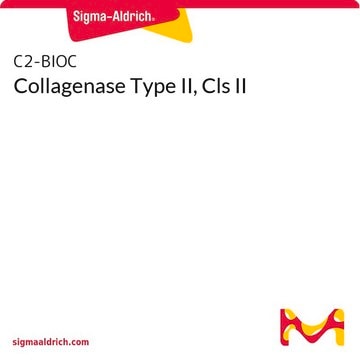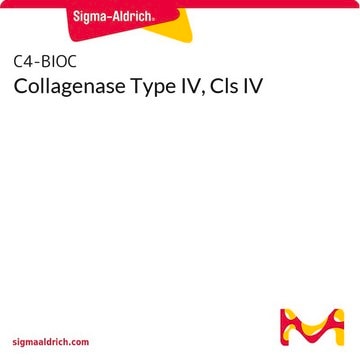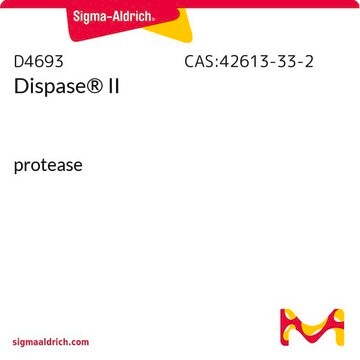Kluczowe dokumenty
1148090
USP
Collagenase II
United States Pharmacopeia (USP) Reference Standard
Synonim(y):
Collagenase from Clostridium histolyticum, Clostridiopeptidase A
Wybierz wielkość
2040,00 zł
Wybierz wielkość
About This Item
2040,00 zł
Polecane produkty
klasa czystości
pharmaceutical primary standard
producent / nazwa handlowa
USP
Zastosowanie
pharmaceutical
Format
neat
temp. przechowywania
−70°C
Szukasz podobnych produktów? Odwiedź Przewodnik dotyczący porównywania produktów
Opis ogólny
Zastosowanie
- Collagenase Type II for Enhanced Cell Isolation in Biomedical Research: Collagenase Type II is extensively applied in tissue dissociation for isolating cells, crucial for regenerative medicine and tissue engineering. It enables efficient breakdown of the extracellular matrix, facilitating easier cell extraction and purification for use in 3D cell culture and stem cell research. This enzymatic method is invaluable for studies requiring high-purity cell populations, making it indispensable in developing therapies for diseases like Parkinson′s and Alzheimer′s (Park et al., 2024).
- Advancing Tissue Engineering with Collagenase II: In tissue engineering, Collagenase II plays a pivotal role by degrading the collagen matrix in tissues, thereby enabling the cultivation of cells in a controlled environment. This process is essential for constructing tissue structures from the ground up, particularly in developing organoids that mimic natural organ functionalities. The use of high-grade biotech collagenase ensures reproducibility and effectiveness in these sophisticated applications (Wu et al., 2024).
- Collagenase II in 3D Cell Culture Systems: Collagenase II is instrumental in preparing extracellular matrices for 3D cell cultures, which are critical for studying cell behaviors in environments that closely replicate in vivo conditions. This enzyme helps in the accurate study of cellular interactions and pharmacological responses, providing a more realistic assessment of cellular dynamics in medical research (Jiang et al., 2024).
- Role of Collagenase II in Stem Cell Research: Utilizing Collagenase II in stem cell research enhances the isolation and maintenance of stem cells. This is particularly important for applications where the integrity and viability of stem cells are crucial, such as in regenerative medicine and therapeutic cloning. The enzyme′s ability to gently dissociate cells while preserving their functionality makes it a staple in cutting-edge biomedical research (Simón-Pérez et al., 2024).
- Collagenase II for Effective Extracellular Matrix Degradation: The ability of Collagenase II to efficiently degrade collagen-rich extracellular matrices is utilized in various biomedical applications, including cancer research where it aids in tumor microenvironment studies and drug penetration analyses. This enzymatic activity is crucial for understanding the interactions between cancer cells and their surrounding stroma, providing insights into potential therapeutic targets (Mohamed et al., 2024).
Działania biochem./fizjol.
Definicja jednostki
Komentarz do analizy
Inne uwagi
Hasło ostrzegawcze
Danger
Zwroty wskazujące rodzaj zagrożenia
Zwroty wskazujące środki ostrożności
Klasyfikacja zagrożeń
Resp. Sens. 1
Kod klasy składowania
12 - Non Combustible Liquids
Klasa zagrożenia wodnego (WGK)
WGK 1
Temperatura zapłonu (°F)
Not applicable
Temperatura zapłonu (°C)
Not applicable
Wybierz jedną z najnowszych wersji:
Certyfikaty analizy (CoA)
Przepraszamy, ale COA dla tego produktu nie jest aktualnie dostępny online.
Proszę o kontakt, jeśli potrzebna jest pomoc Obsługa Klienta
Masz już ten produkt?
Dokumenty związane z niedawno zakupionymi produktami zostały zamieszczone w Bibliotece dokumentów.
Klienci oglądali również te produkty
Active Filters
Nasz zespół naukowców ma doświadczenie we wszystkich obszarach badań, w tym w naukach przyrodniczych, materiałoznawstwie, syntezie chemicznej, chromatografii, analityce i wielu innych dziedzinach.
Skontaktuj się z zespołem ds. pomocy technicznej








